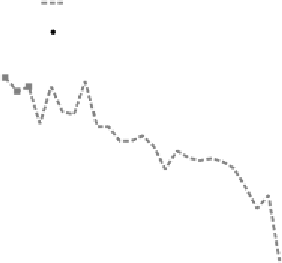Geology Reference
In-Depth Information
Cont. Crust
EM-1 (Tristan)
MORB
Hawaii
HIMU (Tubuai)
Nb
Pb
100
10
1
PRIMITIVE MANTLE
0.1
Rb
Th
U
Ce Nd
P
Hf
Ti
Dy
Er
Al
Fe Mg
Ba
Nb
La
Pb
Sr
Sm Eu Gd
Y
Lu
Ca
Si
COMPATIBILITY
Figure 10.1. Trace element concentrations in mantle-derived rocks. Concentra-
tions are normalised to the estimated concentrations in the primitive mantle. The
Hawaii, Tristan and Tubuai samples are ocean island basalts. EM1 (EM
enriched
mantle) and HIMU (high mu) are different classes of OIB. After Hofmann [176].
Reprinted from
Nature
with permission. Copyright Macmillan Magazines Ltd.
=
incompatible elements in both OIBs and MORBs have concentrations higher than
primitive. For MORBs this is inferred to be due to their being concentrated into
melts during melting, as will be discussed later.
Differences between OIBs and MORBs are evident in isotopic ratios as well.
Figure 10.2 summarises isotopic ratios for strontium, neodymium and lead. MORBs
show less variation than OIBs (Pacific MORB is the most visible in the plots),
although Indian Ocean MORB is intermediate in variation. Some of the variation
may be due to the incorporation of material from continental crust, as is suggested
in panel (c), but much of the variation is intrinsic to the mantle/oceanic crust system.
The Sr-Pb plot (panel (a)) makes clear that at least three components or source
types would be required to explain the range of variation, and in fact five or six
have been proposed [177, 178]. Most of the variations evident in OIBs are also
evident in MORBs, but with a smaller range of variation.
The uranium-lead radioactive decay system is especially useful because it
contains two radiogenic isotopes, and in combination they give age information
[179]. In Figure 10.3(a), the slope of the overall correlation corresponds to an age
of about 1.8 Ga. This would only be an actual age if all samples originated from the
same homogenised source at the same time, which they obviously will not have.
However, it does indicate an approximate aggregate age, though probably with
some bias to greater age. The significance of the correlation will be clarified later.
In the meantime, the correlation does indicate that the isotopic heterogeneities
evident in Figures 10.2 and 10.3 have survived in the mantle for the order of one
to two billion years.

















































